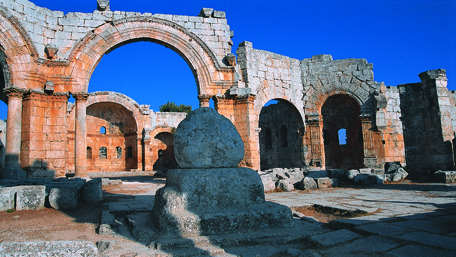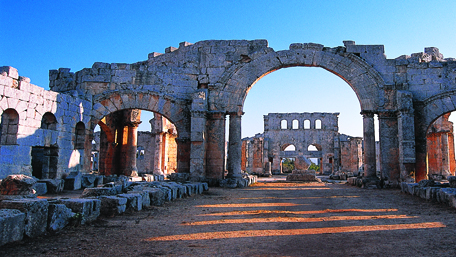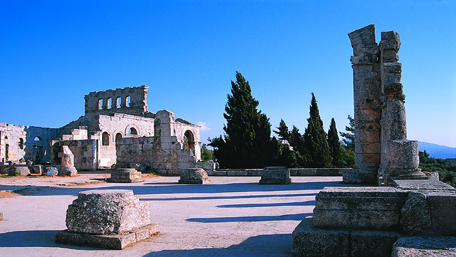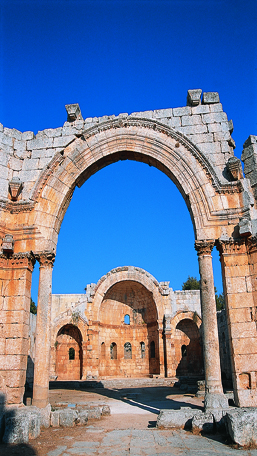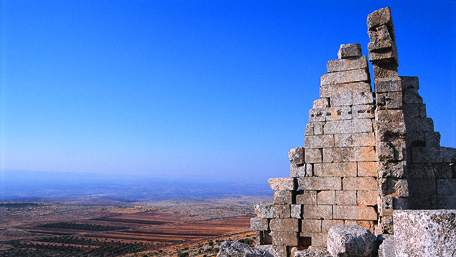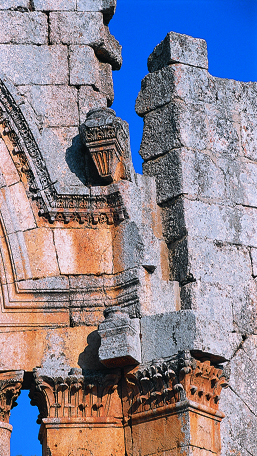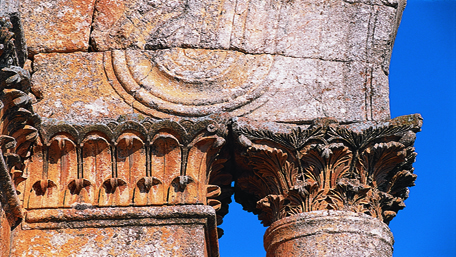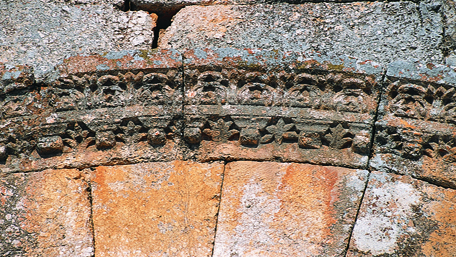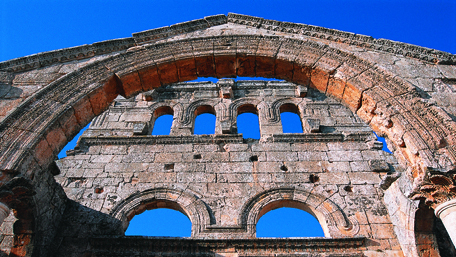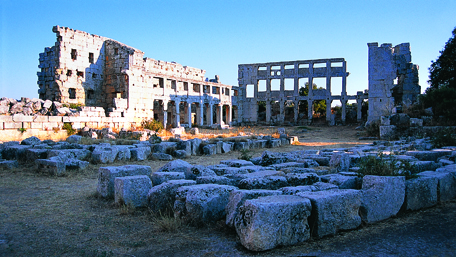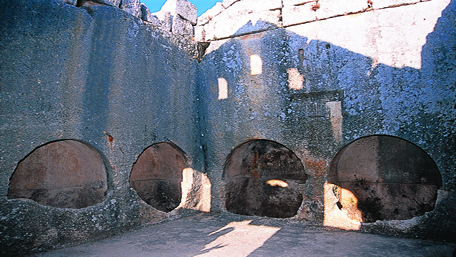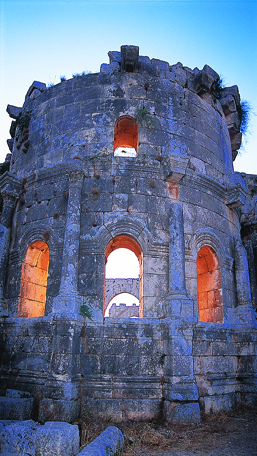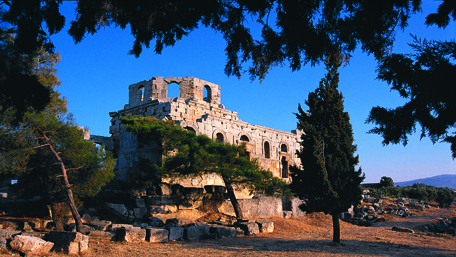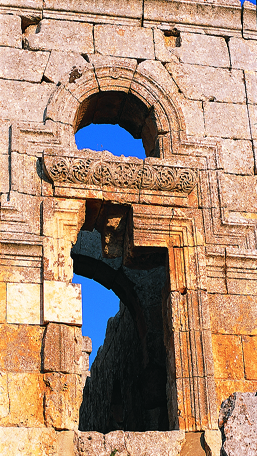And…on this rock, they built a church
At 32 kms from Aleppo. A mountain. A place of pilgrimage. Qal’at Simaan, the citadel of Simeon. The saint lived there 42 years on a pillar. He was called the Stylite. His asceticism fascinated. His faith was mobilizing crowds. When he died, people wanted to make the richest tribute to the man who had made a vow of poverty. Around this pillar was built a large church. Across Syria, Cilicia, Mesopotamia, people rushed to lend a hand to the builders. They built a unique basilica that inspired the Cathedral of Turin and the beautiful friezes of Aya Sofia. More than 100,000 visitors come every year to admire the self-sacrifice of the Holy and beauty of the place of worship that was dedicated to him.
Report Bassam Lahoud
© Prestige / Bassam Lahoud
In the heart of the octagon and the Basilica the column of St. Simeon, or what remains of this pillar of 18-20 meters high.The great basilica was completed around 492…The Arab armies seized the monastery around635, tells Michael the Great. In965, at the time of the Patriarch of Antioch Christophore it becomes fortress at the instigation of the Byzantines. They restored it after the fall of Antioch in969.In revenge of the Byzantines attacks in northern Syria, the hamdanide emir of Aleppo Saad ad-Dawla ordered the attack on Qal Simaan. The Monks and refugees it housed were killed or taken into captivity. The site was reoccupied by the Byzantines as it was attacked twice in1017 by the Fatimid army. The monastery fell into disuse and was abandoned in the early XIIIth century. No mention is made of the monastery during the Crusades. And we don’t find traces of habitat at the site until the XVIth century when the eastern wing of the cruciform church served as a fief to a Kurdish leader. The remains were identified in the thirties, the Basilica then reveals its history and grandeur.
© Prestige / Bassam Lahoud
Among the disciples of Simeon, Daniel, who entered the monastery at the age of 12 years. After receiving the blessing of St. Simeon, he went to Constantinople and settled on the banks of the Bosphorus, at the top of a…pillar. He played an important role in advising King Leon the 1st and Zeno.Precisely when, by whom, by what means this basilica was built? The past remains a mystery
© Prestige / Bassam Lahoud
The arch that connects the central nave and the octagon is decorated on the front “basilica”, unlike the other arches of the three arms of the cross, the faithful could not return to the octagon but were constantly watching the altar at the center of a raised sanctuary of three steps.And Qal Simaan is worn off on the Antioch way…
© Prestige / Bassam Lahoud
A wall was built and at its highest point, a tower was installed, useful for transmitting signals in case of attack. The monastery did become a “Qal”, a citadel…
© Prestige / Bassam Lahoud
The arches of the central octagon wearing acanthus capitals. The pediment of the center rests not on the side as fluted pillars arches but on columns. The Corinthian capitals of arches on columns present a juxtaposition of naturalistic leaves and geometrical patterns.
Its stone lace, chiseled arches would inspire the churches of the West
© Prestige / Bassam Lahoud
The basilica dedicated to St. Simeon was admired by all architects. With Qal Simaan, the carving of the stone, traditional architecture will change dramatically. The arches crowning the apse of the church of Turin were inspired by the décor of the great arches of the octagon. The ornamentation of acanthus leaves gave the sculpture a jagged aspect that is also found in the basilica of Hagia Sophia.
© Prestige / Bassam Lahoud
Remains of the monastery. The monks were able from the building gantry access the stands of the church through a passage. The catechumens were outside the central part of the octagon, they just crossed the apse protected from view by a curtain. In respect of decency, this custom is found in Syria, Jordan Jerash and Cyprus.
© Prestige / Bassam Lahoud
Collective grave. Attached to the north end of the monastery, a collective grave of two levels largely cut in the rock. The upper level contains seven main vaults.
© Prestige / Bassam Lahoud
Its imposing apse opened into the nave by a triumphal arch surmounted by an ornate beautiful cornice with dentil. Unique in Syria, it was flanked by two side apses, side annexes (diakonicon and martyrium) are lacking. The only relic was the column in the center of the octagon.
© Prestige / Bassam Lahoud
South of the plaza, the baptistery, surrounded by monastic buildings. A chapel skirted the baptistery, it was probably reserved for the communion of the newly baptized who no longer had to go in procession through the esplanade to the big church.
© Prestige / Bassam Lahoud
A view of the baptistery.


